August 2018
UP AND DOWN THE ADRIATIC
It was already dark when I arrived in the Croatian capital of Zagreb. I was travelling with Chris, a friend I had met in Nicaragua the previous year and happily agreed to join on a road trip in August 2018. We started the day in Munich, and had arrived in this part of the Balkan Peninsula via Austria and Slovenia. I could hardly believe I had touched four countries in a single day — six hours of driving doesn’t get you very far at all in my home province of Ontario.
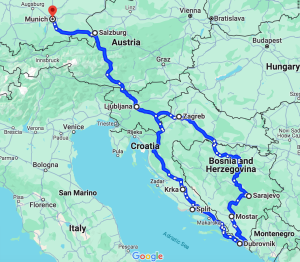
Tourism in Croatia has exploded in the last decade, thanks in part, to Game of Thrones. Its ‘King’s Landing’ scenes were filmed in Dubrovnik’s medieval, stone-walled city, contributing to a growth in visitors of more than 100 per cent from 2010 to 2011, when GOT hit the air on HBO. But Croatia was a popular destination before ‘Jon Snow’ was a household name and rightly so: the country boasts coveted access to the sapphire Adriatic sea, the ruins of great Roman cities, breathtaking national parks and more.
We divided our time in Croatia with a trip to Bosnia and Herzegovina — a most excellent driving route that places Zagreb, Sarajevo, Mostar, Split and Dubrovnik in a single loop.
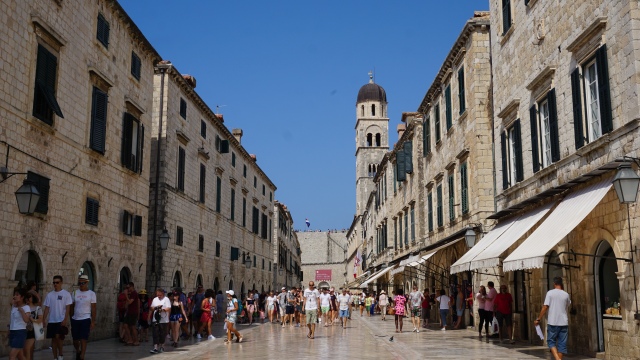
Day Three: Munich to Zagreb (continued)
We made a reservation on the road for the Panorama Zagreb Hotel and arrived in the city around 8 p.m. We paid our city tax of 8 Kuna, per person per night, to the front desk (now increased to Kn10) and set off in search of a drink. According to legend, Zagreb is sort of named after a drink; long ago the city suffered from a severe drought, so an elderly Croatian duke plunged his sword into the earth, and when fresh water sprung up, he cried to his soldiers, ‘Zagrabite!’, ‘Scoop up!’
GOING THE WRONG WAY
Our ears scooped up the revelry of Krivi Put, a beer garden on Savska cesta whose name literally translates to ‘wrong way’ in English. So if you end up overindulging and making a few bad choices there, you can’t say they didn’t warn you. Krivi Put was brimming with young people on a Thursday night, and we ordered rounds of Ožujsko and Karlovačko beer for Kn13 each (less than three Canadian dollars). I later read that Ožujsko is the country’s most popular beer, with 10 bottles consumed every second. If Krivi Put is any indication of the country’s consumption habits, I believe it.
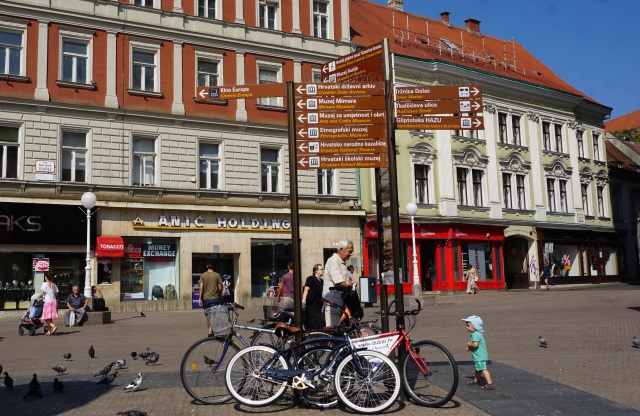
Day Four: Zagreb to Sarajevo
We rose punctually on Friday morning and drove straight downtown to get our choice of parking. I had brunch plans I didn’t want to miss out on, and that meant beating the crowds at the immensely popular Kava Tava on Vrbje ulica.
A MAP FOR KISSING
I know I said there was a quirky romance to Ljubljana, Slovenia, but Kava Tava may be competing to put Zagreb on the list. Every table features a map of the city’s ‘kissing spots,’ including several public places where you’re certain to be spotted. It’s mostly written in Croatian, but an English paragraph reads:
If you’re travel brings you and your loved one in Zagreb, there is nothing more exciting than to experience all kissing spots in Zagreb. Snoop around and don’t stop kissing!
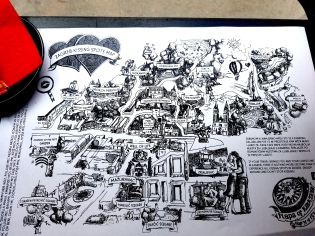 I’m not sure whether this PDA is endorsed solely by Kava Tava or by the city’s residents as well, so proceed with caution in taking the restaurant’s advice. Everything at KavaTava is delicious, from the cappuccinos to the breakfast sandwiches and the portion sizes are big enough you can count on skipping lunch. A plate is about Kn35.
I’m not sure whether this PDA is endorsed solely by Kava Tava or by the city’s residents as well, so proceed with caution in taking the restaurant’s advice. Everything at KavaTava is delicious, from the cappuccinos to the breakfast sandwiches and the portion sizes are big enough you can count on skipping lunch. A plate is about Kn35.
ILICA STREET
Fuelled by the power of free-range eggs, we strolled down Ilica, one of the longest streets in the city and home to some of its most expensive residential addresses. Navigating teeming crowds and watching out for clattering trams, I noticed just how much yellow there is in Zagreb. It seemed to be the colour of choice for many historical buildings, apartment complexes and storefronts. It’s interesting — yellow isn’t even on Croatia’s flag. But it gives the city a very warm and balmy feel.

BAN JELAČIČ SQUARE
We walked east on Ilica until we reached a signpost with about a dozen arrows pointing to attractions in every direction. We were in the main square, the centre of Zagreb’s social life and home of its two most common meeting points: “under the clock,” and “under the horse’s tail.” The tail is in reference to the domineering statue of mid-19th century Croatian politician Josip Jelačić, who sits on horseback in the middle of the square, sword pointing south. Chris and I wanted to get most of our walking done before the sun got too hot, so we started north for St. Mark’s Square.
A favourite way to get there, especially for tourists, is the Zagreb funicular, which has connected the city’s Upper and Lower Towns — notably accident-free — since 1890. It’s the world’s shortest cable railway still used for public transit; the 64-second ride covers just 66 uphill metres, runs every 10 minutes or so and costs just Kn4. It’s a cute feature, but still bouncing with breakfast energy, we took the perfectly well-maintained staircase.
ST. MARK’S SQUARE
The famed St. Mark’s Church seemed to sparkle. Its emblematic red and white tiled rooftop is synonymous with Zagreb; built in 1880 it bears the coat of arms for both the city and the Kingdom of Croatia, Slavonia and Dalmatia. The building itself dates back to the 13th century, and its southern portal is noteworthy for its 15 stone gothic and wooden baroque sculptures of the Virgin Mary, Jesus and his apostles. If you want to go inside, you’ll have to attend a service — 6 p.m. Monday to Friday, 7:30 a.m. on Saturday, and 10:30 a.m. and 6 p.m. on Sunday.

In this part of Gradec, or Upper Town, you’ll also find the Croatian government, Parliament and Constitutional Court, along with the Croatian Museum of Naive Art and the Museum of Broken Relationships. According to the Zagreb Tourist Board, Gradec’s layout, look and feel hasn’t changed much since the 13th century. It was once entirely fortified, and two of its original towers remain intact today: the Popov toranj (Priest’s Tower), which provided refuge to clergymen in case of enemy attack, and the Lotrščak Tower, which kept watch over the city’s southern entrance.
LOTRŠČAK TOWER
If you’re going to spend money on just one attraction in Zagreb, I recommend the Lotrščak Tower. The belvedere of this mid-18th century fortress has a wraparound view of St. Mark’s Square and downtown Zagreb. It’s cannon has fired at noon daily for over a century, and while it usually costs €5 to climb, we got lucky: we were told there was “no lady” to collect our cash, so we could go up for free. The panorama was worth the huffing and puffing:

YELLOW BUILDINGS, GREEN PARKS
We went for a stroll in Lower Town, the newest part of Zagreb. The city has more than 4,500 cafés and restaurants — one café for every 175 or so residents, boasts the Zagreb Tourist Board. There’s even a designated “coffee strip,” a pedestrianized stretch known as Špica or “The Peak.”
 Amongst the outdoor terraces and aroma of hot cappuccinos, I saw more outdoor couches than I had ever seen before. UK journalist Natalie Chalk writes about how to make the most of the city’s coffee culture in this helpful article.
Amongst the outdoor terraces and aroma of hot cappuccinos, I saw more outdoor couches than I had ever seen before. UK journalist Natalie Chalk writes about how to make the most of the city’s coffee culture in this helpful article.
We made our way next through the patchwork of squares and parks known as the Lenuci Horseshoe, encompassing the city’s beautiful Botanical Garden, along with museums, galleries, fountains, and mostly yellow buildings. We picked up some lemonade from a stall, and enjoyed the quiet away from the concentration of tourists at Ban Jelačic Square.
DOLAC MARKET
Around noon, we returned to the square, which is also next to the largest farmer’s market in Zagreb. Welcoming visitors at Dolac’s entrance is the statue of a kumica, the word for the women from nearby villages who traditionally sell food at the market. It’s a tribute to their indispensable role in fuelling the city, writes the Zagreb Tourist Board. Dolac was created in 1930, and today, a large sea of red umbrellas shades all kinds of produce — cherries, cheese, meat, olive oil, and more. Unfortunately, the parasols did little to protect these goods from bees, which seemed to claim every available inch of unwrapped food.
From there, we hit the road to Sarajevo — a five-hour drive that turned into an eight-hour adventure as we ran into engine trouble and standstill traffic in the countryside, and made a surprisingly beneficial mistake at the Bosnian border.
Click here to follow my itinerary to Bosnia and Herzegovina, or scroll down to continue in Croatia, where we returned in the second half of our road trip.

Know Before You Go: Zagreb
Travel Tips
- The early bird gets the worm in a crowded city like Zagreb. Rise early for choice access to parking spots and attractions.
- Download a map of the city for offline use and mark your favourite spots for free using Maps.me or Organic Maps.
Where to Stay
- The Panorama Hotel Zagreb has comfortable air-conditioned rooms with WiFi access for Kn16 per night, inclusive of parking. It’s not quite within walking distance of downtown.
Day Six: Sarajevo to Dubrovnik (continued)
Bosnia and Herzegovina was a relatively affordable place to travel, but Dubrovnik — launched to new heights by Game of Thrones — was much tougher on our wallets. After dropping off our Polish backpacking guests, Tomac and Sebastien, we stopped in a small town called Trsteno, where we could set up a tent and use the washrooms for 20 EUR. It was about 20 minutes’ drive outside of the city.
 The grounds at Auto Camp Trsteno are beautiful and within walking distance to docks overlooking the Adriatic Sea. We tried to pay the owner for our stay, but he kindly waved us on to the campsites, insisting we could square up some other time. We pitched our tent, inflated our mattress and set off in search of food.
The grounds at Auto Camp Trsteno are beautiful and within walking distance to docks overlooking the Adriatic Sea. We tried to pay the owner for our stay, but he kindly waved us on to the campsites, insisting we could square up some other time. We pitched our tent, inflated our mattress and set off in search of food.
We found a small restaurant in town, filled up on fish and vegetables, and strolled down to the water to see the full moon.
Day Seven: Dubrovnik
Anticipating a nightmare trying to find parking, we rose early the next day. We skipped breakfast, drove into Dubrovnik, and turned back around after failing to find a spot that would cost us less than EUR70 a day. By the time we found a semi-legal parking space (a shoulder off the highway about a 20-minute walk away), the sun had risen and it was scorching. We decided it would be less expensive to pay for a parking ticket than a parking lot, and sweating, made our descent into the Old Town.
STRADUN
We entered through 15th century Pile Gate, which you may recognize from Game of Thrones — most notably, Season 2’s King’s Landing riot scene. The gate, whose wooden drawbridge was replaced with stone long ago, leads the way to Stradun, the Old Town’s main strip, which is lined with cafes, shops and restaurants.
We made our way through the crowds in the sweltering fortress, taking note of the beautifully-restored medieval architecture, and the exceptional preservation of its original buildings, some of which were built between the 13th and 16th centuries. We bought a one-day Dubrovnik Card for Kn250, which covered access to six museums, two galleries, the walls of Ragusa and the cost of public transit for 24-hours.
THE WALLS
We began by scaling the steps to Dubrovnik’s legendary walls, whose easiest-to-find entrance is by the Pile Gate. We entered by Sv. Dominika on the east end of Stradun, to work backwards and avoid some of the lineups.
The walls are widely considered one of the greatest fortification systems of the Middle Ages, built mostly between the 12th and 17th centuries to provide nearly two kilometres of protection around the city. A massive earthquake in 1667, remarkably, did little damage to them. If you’re crunched for time, I recommend starting with the walls — of all the attractions Dubrovnik has to offer, this one is not to be rushed.

There is something stunning to look at in every direction, from the bright blue and green Adriatic Sea, dotted by yachts and fishing vessels, to the red-tiled rooftops of the Old City, or their back drop, the green slopes of Mount Srđ. Peering into the city, you’re like to see laundry lines strung between unit windows and folks enjoying a drink in their courtyards — a reminder that despite the hoards, Dubrovnik is still home to more than 40,000 permanent residents.
There are six fortresses along the walls: Lovrijenac, Revelin, Minčeta, Bokar, St. John, and St. Lucas. Lovrijenac, on the western part of the barricade, dates from the 11th century, and was purpose-built to defend the city from the Venetians. It played host to the ‘Red Keep’ in Game of Thrones, and entrance is free with a ticket that covers entrance to the walls. According to ‘GoDubrovnik,’ you can even rent the fortress to be married at the Red Keep, “and enjoy one of the most beautiful views of King’s Landing.” The Battle of the Blackwater was also filmed by the sea-facing walls of Dubrovnik.
THE OLD TOWN
Once we had our fill of scenery from the fortresses, we turned back to our one-day passes. The Old Town was a sweltering maze, teeming with thousands of people carrying the same red-and-blue city maps.
We visited the Friars Minor Franciscan Monastery Museum first, which houses a pharmacy that has been an active dispensary since a record-setting 1317. Found next to the Pile Gate, the museum also holds “one of the most priceless collections of literature on pharmacology and medicine, with over 2,000 prescriptions,” according to the Dubrovnik Card website.

Our next stop was the Cultural Historical Museum inside the Rector’s Palace, where we encountered the largest crowds. The palace itself was home to the rector of the Republic of Ragusa, and has been built, rebuilt and renewed several times due to an earthquakes and a gunpowder explosion. It contains the government official’s office and private rooms, scribes’ offices and a dungeon, along with piles of furniture, weapons, coins, paintings, and uniforms from the day.
Finally, we toured the Rupe Etnographic Museum, set up in a 16th century granary in the southwestern part of the Old City. It is so named for the rupe — the stone silos in which the Dubronik Republic kept its reserves of wheat, barley and millet. Inside the museum are a range of old domestic and agricultural tools and traditional clothing and textiles.
UVALA LAPAD
Church bells continued to ring throughout the day, and our heads, already dizzy from heat, were ready for a break. Using our day pass, we took the number 6 bus from the Old City to Lapad, a large and luxurious peninsula just west of Dubrovnik. We stopped for a late lunch at Mamma Mia’s Pizzeria, and then walked to the beach to watch the sunset. We were relieved at the end of the day to find our car where we left it and returned to Camp Trsteno. Leftover pizza in hand, we made our way down to the Haven Trsteno boat launch, dangled out feet in the water, and watched the night fishermen under a full moon.
Know Before You Go: Dubrovnik
Travel Tips
- Parking spots are almost impossible to come by, even if you can afford one. I recommend entering via public transit or cab. Spare yourself the pain.
- Check out the Dubrovnik Card website in advance to determine what pass —one, three or seven-day — you want. The one-day option covered most of what I was interested in for Kn250, inclusive of public transit for 24 hours.
- Choose your museums wisely. Overall, I found a walk around the Old City to be more rewarding than some of the rather scant museum collections. The ethnographic museum was particularly disappointing.
- Prepare for sweltering heat and little shade on the walls of Dubrovnik in the summer. Vendors sell water along the route for an outrageous price, so I recommended arriving fully loaded with a fan or parasol as well.
Where to Stay
- Auto Camp Trsteno has camping sites, inclusive of vehicle space and access to flush toilets and showers, for about EUR20. It’s a quiet and affordable option just outside of the city with beautiful of the sea. Make a reservation by emailing camping-trsteno@trsteno.hr or calling +385 (0)20-751060.
Day Eight: Dubrovnik to Split
The next morning we took off for Split, a three-hour drive west along the coastline from Dubrovnik. On the road, we passed signs warning of wild pigs as we cruised through mountain valleys and passed glistening rivers and tributaries of the Adriatic Sea. Fresh fish and fruit vendors dotted the sides of the road, their wares enticingly stacked in colourful displays.
 The biggest obstacle we encountered on our first day in Split was trying to find a safe place to park overnight. We ended up driving into a pedestrian-only area, and having to back out apologetically out as angry Croats flipped us the bird. If you can park outside the core and take the bus in, that’s the way to go. We dropped out bags off at the Silver Central Hostel and started with the Old Town.
The biggest obstacle we encountered on our first day in Split was trying to find a safe place to park overnight. We ended up driving into a pedestrian-only area, and having to back out apologetically out as angry Croats flipped us the bird. If you can park outside the core and take the bus in, that’s the way to go. We dropped out bags off at the Silver Central Hostel and started with the Old Town.
DIOCLETIAN’S PALACE
You may see lots of advertisements online for a free walking tour of old Split, but I wish you luck actually finding one. Unlike Dubrovnik, however, Split is very well marked and easy to navigate from a tourist’s perspective.
The Old Town is built around the Roman Emperor Diocletian’s palace, seven acres of fortified imperial living and one of the best preserved monuments of Roman architecture in the world. Built at the end of the third century, it has four major gates — Golden, Silver, Iron and Brass — the first of which, only the emperor’s family was allowed use. By that gate stands the well-loved, 28-foot statue of Gregory of Nin, a Croatian bishop in the Middle Ages who took on the Pope by introducing the use of the national language in religious services. Rub his big toe for good luck, I guess.
Other remarkable features of the palace complex include the Temple of Jupiter, marked by well-preserved granite sphinxes brought from Egypt by Diocletian — who was celebrated as the living son of Roman god — and the Middle Ages Cathedral of Saint Domnius, housed inside the emperor’s mausoleum. The latter is one of the oldest Christian buildings and smallest cathedrals in the world. You can climb the bell tower for about Kn15 or as part of a more expensive package that includes entry to other historical sites in the area.
PERISTIL, PJACA AND PAZAR
If you can, try to catch the changing of Diocletian’s Roman Guards at the Peristil, the Old Town courtyard, daily at noon. The legionaries’ costumes are a bit hokey, but it’s quite something to watch the ceremony under the eyes of the nearby 3,500-year-old granite sphinx — one of 12 stolen from Egypt when the palace was built.
“Dear God, how many feet have stepped through here.” — Pope John Paul II upon entering the Peristil in 2000.
In Pjaca, the People’s Square, you’ll find teeming cafés and restaurants, the heart of Split’s social life since Medieval Times.
 It’s clock is notable, one of few still ticking with 24 numbers instead of 12, as is its bookshop, Morpurgo, reportedly one of the oldest in the world, open since 1861. Despite the history entrenched in in the square, I think the cramped alleyways of the Old Town are equally worth exploring, concealing elements of Split’s modern character — heaps of shop and restaurant garbage, exhausted staff cramming in a quick smoke break, cats everywhere, graffiti, and hanging laundry.
It’s clock is notable, one of few still ticking with 24 numbers instead of 12, as is its bookshop, Morpurgo, reportedly one of the oldest in the world, open since 1861. Despite the history entrenched in in the square, I think the cramped alleyways of the Old Town are equally worth exploring, concealing elements of Split’s modern character — heaps of shop and restaurant garbage, exhausted staff cramming in a quick smoke break, cats everywhere, graffiti, and hanging laundry.
The Pazar and fish markets also offer a slice of more authentic Split life, but like everything else in the legendary city, it’s shoulder-to-shoulder in the high season. This is a great (and less expensive) place to grab a fresh lunch before heading down to the waterfront. It’s also the perfect place to buy fresh or dried lavender, if you’re in need of it.
RIVA AND VIEWPOINT TO MARJAN
The city’s main promenade, Riva, underwent substantial change during the French’s brief rule over Croatia in the early 1800s. It’s now the site of expensive places to wine and dine, and dotted with yachts moored at the port.

Here, we picked up some gelato and strolled upward, following signs for the viewpoint to Marjan, a hill overlooking the spectacular red rooftops of and white facades of Split. This isn’t a sight to miss, especially at sunset.
We made our way back into the Old Town for dinner and drinks, enjoying a relatively inexpensive meal at Fife, where freshly caught bass and risotto seemed to be the thing to order. We capped that off with Ferrero Rocher cake from the Luke Ice Cream and Cake shop. Ten out of 10.

SPLIT AT NIGHT
There’s never a lull in Split. It’s almost busy at night as it is during the day, with thousands cramming themselves into bars, restaurants and the Pjaca for people-watching and socializing.
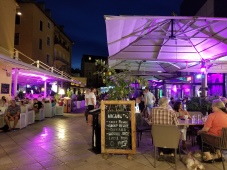 Chris and I had a drink at the famous Charlie’s Backpacker Bar, which features local beers like Medvedgrad, Ožujsko, Karlovačko, and Zmajsko, and another at the Sanctuary Bar on Kružićeva Street. We had a rich conversation with two Croats who live in the Diocletian’s Palace complex and insisted quite earnestly that they don’t mind the crowds or tourists — it’s what brings jobs and revenue to young adults like them.
Chris and I had a drink at the famous Charlie’s Backpacker Bar, which features local beers like Medvedgrad, Ožujsko, Karlovačko, and Zmajsko, and another at the Sanctuary Bar on Kružićeva Street. We had a rich conversation with two Croats who live in the Diocletian’s Palace complex and insisted quite earnestly that they don’t mind the crowds or tourists — it’s what brings jobs and revenue to young adults like them.
Day Nine: Split to Krka
After a poor night’s sleep (someone at the hostel had stolen our bunks), we packed up for Trogir, a picturesque Dalmatian town of about 11,000 people, a half hour’s drive west of Split. The small island is connected to the mainland by a bridge, and you can get there by bus in the same amount of time, with various routes available.
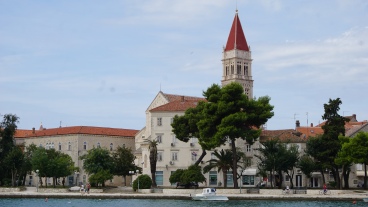
TROGIR
Trogir served as the backdrop for the Game of Thrones trading harbour of Qarth, where the bad guys imprisoned Daenerys Targaryen’s dragons in Season 2. That means, of course, it was crowded.
There’s evidence of Neanderthal occupation of Trogir from some 45,000 years ago, but modern settlement of the area traces back to third-century Greeks. The Old Town’s more “modern” buildings went up between the 13th and 16th centuries under Croatian and Hungarian rule, but at various times throughout its history, the town has been occupied by the French, the Italians, the Austrians, the Serbians, and the Yugoslavians.

Enter the old walled city through the North Gate, built in the 15th century and decorated by the town’s patron saint, John Trogir, and St. Mark’s Lion. Inside the Old Town, you’ll easily identify the white-faced City Clock Tower or Church of St. Sebastiana — constructed as a “vow of salvation from the plague,” according to the town’s tourism website. Not far from that is the Church and Monastery of St. Dominic, used for a few filming scenes on the streets of Qarth and visible from the waterfront promenade.
On the southwestern tip of the island is the Kamerlengo Fortress, built between 1420 and 1437 during the Venetian conquest. If local legend is to be believed, the man it’s named after fell in love with a woman he couldn’t have, had a daughter with someone else who ended up looking like his true love, wound up alone and never spoke again.
KRKA NATIONAL PARK
From Trogir, we drove a short distance north to Krka National Park, where we pitched our tent for the rest of the day. We stayed at Camp Vrata Krka (which also has a hotel option) and paid our entrance fee to the park — about Kn148.
The grounds include more than 109 square kilometres of the Krka River and its basin, seven waterfalls, and 1,022 different species of plants. According to the brochure, like Trogir, there is evidence of humans in the region dating back to prehistoric times. Its modern offerings include the remnants of a Roman military camp and medieval Croatian fortresses, and the still-standing Franciscan church and monastery of 1445. You have to take a boat to that site on Visovac Island, and a combination of either a boat or a car is required to reach many others.
We had a late lunch at the Skradinski buk, “one of Crotia’s best known natural wonders,” as described by the national park. To get there, most visitors take a free shuttle bus from the Lozovac entrance, but the lineup was long, so Chris and I walked the kilometre-or-so trail down to the falls instead. The falls are truly stunning, white water cascading over edges into a turquoise basin in a backdrop of bright green forest. We swam, ate and explored the grounds, including the pre-industrial water mills and a two-kilometre walking trail.
The late afternoon we dedicated to the Roški slap, a lush and green circular trail through a canyon over the Orglice waterfall, also called the Necklaces. We climbed more than 500 wooden stairs to reach the Oziđana pećina cave, a hideaway for humans since the late Stone Age. It was beautiful, and we had it all to ourselves, as most visitors spend the afternoon hours at the popular waterfalls.
SKRADIN
We left Roški slap for the nearby Skradin just as the sun began to dip below the horizon. It’s a small town by the entrance of the national park, with bright brick-red rooftops and white buildings. There weren’t a pile of dining options, so fresh fish and pizza it was at the Konoba Pizzeria Patriot, with a bunch of other park visitors.
We took a leisurely stroll through Skradin and found an outdoor band playing romantic music by the town’s basketball courts as a game was going on. We watched and listened in the glow of the waterfront lights, lined with some of the most luxurious-looking yachts I had ever seen. Things of which I know not, I thought, as I rolled out my sleeping bag at the camp.

Day 11: Krka to Munich, via Slovenia and Austria
Click here to follow my itinerary to Austria, then Germany.
Know Before You Go: Split, Krka
Travel Tips
- Parking is a nightmare. If you can leave your vehicle on the outskirts of Split and walk, take a bus or cab in, you’ll save yourself a world of pain.
- Mid to late afternoon is a good time to visit Roški slap. Most of the crowds are still at the Skradinski buk waterfalls, so you’ll have relative peace and quiet on the stunning trails, have the benefit of hiking after the sun has peaked, and be able to watch the sunset.
Where to Stay
- The Silver Central Hostel offers affordable, shared accommodations in a central location for Kn 190 per person, inclusive of breakfast. When someone took one of our bunks, they waived our costs.
- Camp Vrata Krka offers quiet, clean camping sites (without much privacy) for about Kn 215, inclusive of access to flush toilets, sinks and showers. We also paid Kn 8 each as an accommodation tax.
- Check out Booking.com for more accommodation options that can be easily booked on the road.
























































